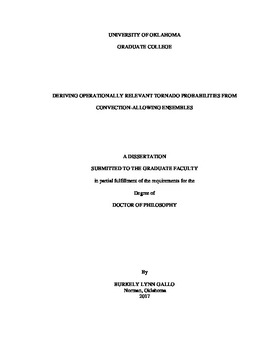| dc.contributor.advisor | Clark, Adam | |
| dc.contributor.advisor | Wang, Xuguang | |
| dc.contributor.author | Gallo, Burkely | |
| dc.date.accessioned | 2017-12-08T14:45:07Z | |
| dc.date.available | 2017-12-08T14:45:07Z | |
| dc.date.issued | 2017-12 | |
| dc.identifier.uri | https://hdl.handle.net/11244/52733 | |
| dc.description.abstract | Hourly maximum fields of simulated storm diagnostics from experimental versions of convection-allowing models (CAMs) provide valuable information regarding severe weather potential. The focus of this work is to extract operationally relevant tornado probabilities from the CAM-based Weather Research and Forecasting (WRF) ensemble initialized daily at the National Severe Storms Laboratory (NSSL-WRF). Probabilities are derived in three main ways: by using updraft helicity (UH), UH filtered by model-derived environmental parameters, and through combining UH and model-derived environmental parameters with observed climatological tornado frequencies. Contrasting these methods compares a binary threshold exceedance approach and a probabilistic paradigm. Rather than using a specific threshold of UH as a proxy for tornadogenesis and relying on the ensemble to generate probabilities, the probabilistic approach treats each point as having a certain probability of producing a tornado, depending on the surrounding environmental conditions. Additionally, the ensemble-generated forecasts using both approaches are compared with the 0600 UTC Storm Prediction Center (SPC)’s tornado probabilities, to determine whether ensemble forecasts approach the skill of expert forecasters. While the methods derived using the threshold approach overforecast tornado probability magnitude, the probabilities that incorporate climatological frequency information perform much more reliably, particularly when the storm timing was considered. For the probabilistic forecasts to be operationally relevant, cooperation with forecasters is critical in their development. A database of right-moving supercells developed by SPC forecasters was used to generate the climatological frequencies on which three sets of probabilities are based. Through NOAA’s Hazardous Weather Testbed Spring Forecasting Experiment (SFE), subjective daily evaluation of the probabilistic forecasts provided feedback during SFE 2015 that led to the development of the climatological frequency probabilities. When the climatological frequency probabilities were evaluated in SFE 2017, the prevalence of false alarm from nocturnal mesoscale convective systems led to the incorporation of timing information which reduces that false alarm. Therefore, the forecast probabilities are targeting the right-moving supercells, reflecting the underlying climatological frequencies. | en_US |
| dc.language | en_US | en_US |
| dc.subject | Forecasting | en_US |
| dc.subject | Tornadoes | en_US |
| dc.subject | Convection-Allowing Ensembles | en_US |
| dc.subject | Numerical Weather Prediction | en_US |
| dc.title | Deriving Operationally Relevant Tornado Probabilities from Convection-Allowing Ensembles | en_US |
| dc.contributor.committeeMember | Brooks, Harold | |
| dc.contributor.committeeMember | Cavallo, Steven | |
| dc.contributor.committeeMember | Richman, Michael | |
| dc.contributor.committeeMember | Trytten, Deborah | |
| dc.date.manuscript | 2017-12 | |
| dc.thesis.degree | Ph.D. | en_US |
| ou.group | College of Atmospheric & Geographic Sciences::School of Meteorology | en_US |
